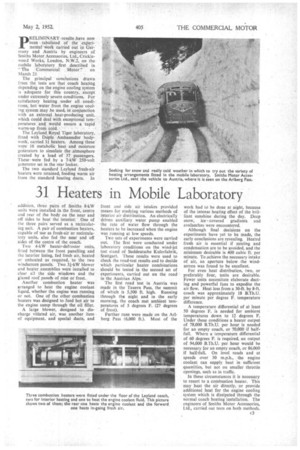31 Heaters in Mobile Laboratory
Page 41

If you've noticed an error in this article please click here to report it so we can fix it.
addition, three pairs of Smiths 8-kW units were installedla the front, centre and rear of the body on the near and off sides to heat the interior. One of the three pairs served as a recirculating unit. A pair of combustion heaters, capable of use as fresh-air or recirculatory units, also fed the near and off sides of the centre of the coach.
Two 4-kW heater-defroster units, fitted between the front panelling and the interior lining, fed fresh air, heated or unheated as required, to the two windscreen panels. Two 3-kW blower and heater _assemblies were installed to clear all the side windows and the glazed roof panels of mist or frost.
Another combustion heater was arranged to heat the engine coolant liquid, whether the engine was running or not. One of the other combustion heaters was designed to feed hot air to the engine sump through the oil filler.
A large blower, designed to discharge vitiated air, was another item of equipment, and special ducts, and front and side air intakes provided means for studying various methods of interior air distribution. An electrically driven auxiliary water pump enabled the rate of water flow through the heaters to be increased when the engine was running at low speeds.
Two sets of experiments were carried out. The first were conducted under laboratory conditions on the wind-jet test stand of Suddeutsche Kulerfabrik, Stuttgart. These results were used to check the road-test results and to decide which particular heater combinations should be tested in the second set of experiments, carried out on the road in the Austrian Alps.
The first road test in Austria was made in the Tauern Pass, the summit of which is 5,500 ft. high. Running through the night and in the early morning, the coach met ambient temperatures of 5 degrees F. (27 degrees of frost).
Further runs were made on the Adberg Pass (6,000 ft.). Most of the work had to be done at night, because of the intense heating effect of the brilliant sunshine during the day. Deep snow, ice covered gradients and avalanches were encountered.
Although final decisions on the experiments have yet to be made, the early conclusions are revealing. Heated fresh air is essential if misting and condensation are to be avoided, and the minimum desirable is 400 cubic ft. per minute. To achieve the necessary intake of air, an aperture below the windscreen was found to be excellent.
For even heat distribution, two, or preferably four, units are desirable. Fewer units necessitate elaborate ducting and powerful fans to expedite the air flow. Heat loss from a 30-ft. by 8-ft. coach was approximately 18 B.Th.U. per minute per degree F. temperature difference.
A temperature differential of at least 50 degrees F. is needed for ambient temperatures down to 12 degrees F. Under these conditions a heater output of 78,000 B.Th.U. per hour is needed for an empty coach, or 70,000 if halffull. Where a temperature differential of 60 degrees F. is required, an output of 94,000 B.Th.U. per hour would be necessary for an empty coach, or 86,000 if half-full. On level roads and at speeds over 30 m.p.h., the engine coolant can supply heat in sufficient quantities, but not on smaller throttle openings, such as in traffic.
In these circumstances it is necessary to resort to a combustion heater. This may heat the air directly, or provide additional heat for the engine cooling system which is dissipated through the normal coach heating installation. The engineers of Smiths Motor Accessories, Ltd., carried out tests on both methods.




















































































